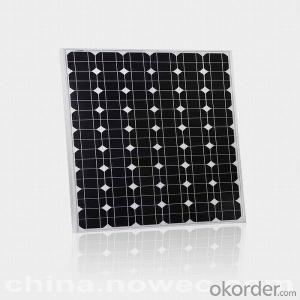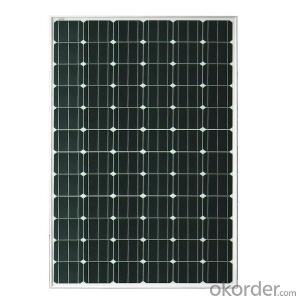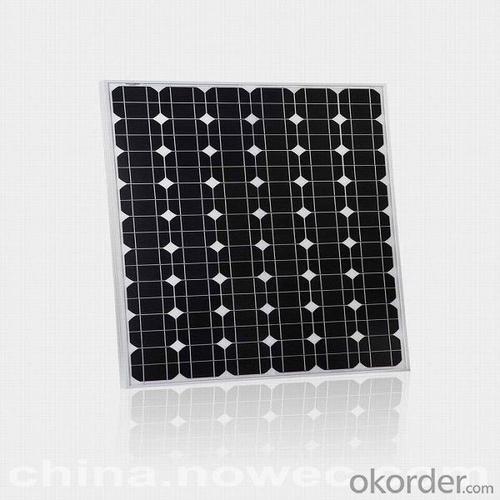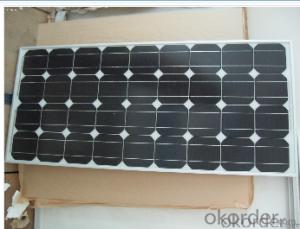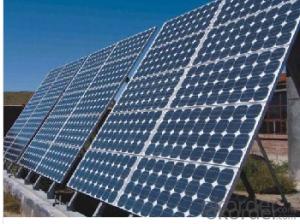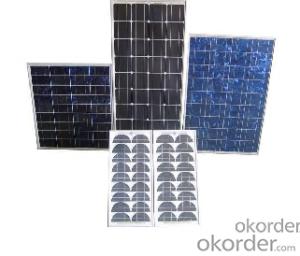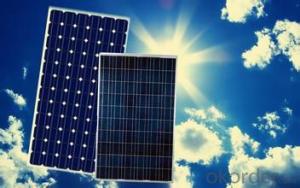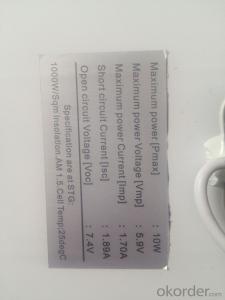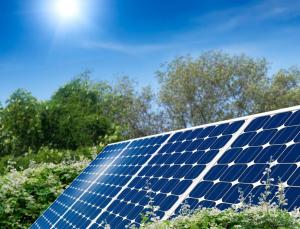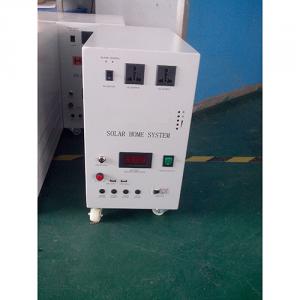Small Solar Panels for Home:60Wp Maximum Power Solar Power System
- Loading Port:
- Tianjin
- Payment Terms:
- TT OR LC
- Min Order Qty:
- 1000 watt
- Supply Capability:
- 10000000 watt/month
OKorder Service Pledge
OKorder Financial Service
You Might Also Like
Specification
Product Description
Key Specifications/Special Features
Maximum power: 60Wp
Maximum power voltage: 18.00V
Maximum power current: 3.33A
Open circuit voltage: 21.60V
Short circuit current: 3.60A
Number of cells: 36 pieces (4 x 9)
Cell dimensions: 78 x 156mm
Module dimensions: 766 x 680 x 30mm
Maximum system voltage: 1,000V
Temperature coefficients of Isc: + 0.1%/
Temperature coefficients of Voc: -0.38%/
Temperature coefficients of Pm: -0.47%/
Temperature coefficients of Im: +0.1%/
Temperature coefficients of Vm: -0.38%/
Temperature range: -40 to +85C
Surface maximum load capacity: 60m/s (200 kg/m²)
Allowable hail load: steel ball fall down from 1m height
Weight per piece: 7kgs
Junction box type: PV-JB001 (TUV)
Connectors and cables type with TUV certificate
Length of cables: 900mm
Output tolerance: ±3%
Frame (material, corners and more): aluminum
Standard test conditions: 1,000W/m², AM1.5 25'C
Warranty 10 years product warranty and 25 years 80% ofpower
FF: e70%
Quantity of one 20-foot container: 500 pieces
Quantity of one 40-foot HQ container: 1,000 pieces

Product Details
| Electrical Data | Module Size | Weight | Number of cells series | ||||
| Nominal Power | Max-Power | Max-Power | Open-Circuit | Short-Circuit | |||
| Voltage | Current | Voltage | Current | ||||
| Pmax | VMPP | IMPP | VOC | ISC | |||
| W | V | A | V | A | mm | Kg | pc |
| 10 | 17.2 | 0.58 | 21.6 | 1.31 | 340*254*17 | 1.2 | 36 |
| 20 | 17.2 | 1.16 | 21.6 | 1.93 | 340*460*25 | 1.8 | 36 |
| 30 | 17.2 | 1.74 | 21.6 | 2.57 | 350*670*30 | 3 | 36 |
| 40 | 17.2 | 2.32 | 21.6 | 3.23 | 450*670*30 | 3.5 | 36 |
| 50 | 17.2 | 2.91 | 21.6 | 3.86 | 550*670*30 | 4.5 | 36 |
| 60 | 17.2 | 3.49 | 21.6 | 3.86 | 603*670*30 | 5.3 | 36 |
| 70 | 17.2 | 4.07 | 21.6 | 4.51 | 758*670*30 | 6 | 36 |
| 80 | 17.2 | 4.65 | 21.6 | 5.17 | 758*670*30 | 6.5 | 36 |
| 90 | 17.2 | 5.23 | 21.6 | 5.81 | 935*670*30 | 6.7 | 36 |
| 100 | 17.2 | 5.8 | 21.6 | 6.46 | 935*670*30 | 6.7 | 36 |
| 110 | 17.2 | 6.4 | 21.6 | 7.08 | 1061*670*35 | 8 | 36 |
| 120 | 17.2 | 6.98 | 21.6 | 7.72 | 1161*670*35 | 8.6 | 36 |
| 130 | 17.2 | 7.56 | 21.6 | 8.4 | 1277*670*35 | 9.8 | 36 |
| 140 | 17.2 | 4 | 21.6 | 4.4 | 1480*670*35 | 10.9 | 36 |
| 150 | 17.2 | 4.17 | 21.6 | 4.58 | 1480*670*35 | 10.9 | 36 |
| 160 | 34.4 | 4.65 | 43.2 | 5.17 | 1480*670*35 | 10.9 | 72 |
| 170 | 34.4 | 4.94 | 43.2 | 5.49 | 1172*983*35 | 11.7 | 72 |
| 180 | 34.4 | 5.23 | 43.2 | 5.81 | 1172*983*35 | 11.7 | 72 |
| 190 | 34.4 | 5.52 | 43.2 | 6.14 | 1260*983*35 | 14.6 | 72 |
| 200 | 34.4 | 5.81 | 43.2 | 6.5 | 1260*983*35 | 14.6 | 72 |
| 210 | 34.4 | 6.1 | 43.2 | 6.85 | 1488*983*35 | 14.6 | 72 |
| 220 | 34.4 | 6.4 | 43.2 | 7.08 | 1488*983*35 | 15.2 | 72 |
- Q: Can solar panels be used for agricultural purposes?
- Yes, solar panels can be used for agricultural purposes. They can power various agricultural operations such as irrigation systems, livestock watering, and crop drying. Additionally, solar panels can also be used to generate electricity for running farm equipment and storing energy for future use. Their sustainable and renewable nature makes them an ideal choice for promoting energy efficiency and reducing reliance on fossil fuels in agriculture.
- Q: Do solar panels work during a power outage?
- No, solar panels do not work during a power outage unless they are connected to a battery storage system.
- Q: Can solar panels be used in countries with limited sunlight?
- Yes, solar panels can still be used in countries with limited sunlight. While solar panels are most effective in regions with abundant sunlight, they can still generate electricity in areas with less sunlight. Even countries with limited sunlight exposure can benefit from solar energy by utilizing advanced solar technologies and optimizing panel placement to maximize energy production. Additionally, solar panels can still generate electricity on cloudy or overcast days, although at a reduced efficiency compared to sunny days.
- Q: Can solar panels be installed on a university campus or educational facility?
- Yes, solar panels can certainly be installed on a university campus or educational facility. In fact, many institutions have already embraced solar energy as a sustainable and cost-effective solution. Solar panels can be installed on rooftops, parking structures, or open fields to generate clean electricity and reduce the carbon footprint of the campus. This not only helps in meeting sustainability goals but also provides an educational opportunity for students to learn about renewable energy and its environmental benefits.
- Q: Can solar panels be used in areas with high levels of snowfall?
- Yes, solar panels can be used in areas with high levels of snowfall. However, the performance and efficiency of the panels may be affected during snowy conditions. Regular snow removal or tilted mounting angles can help maximize their effectiveness in such areas.
- Q: i need technical and non technical details to generate MW power by solar panels
- Sorry if I don't have all the specifics you asked for, but Sun Power makes the most efficient solar panels on the market, at close to 20% efficiency. They have made cells with up to 25% efficiency in the lab. That doesn't make it the cheapest but means the most watts per square foot. Thin film panels are cheaper to make but not as efficient. They are about half as efficient as conventional silicon panels. First Solar makes the cheapest per watt right now. So I guess that makes them the actuall cheapest manufacturer. They are able to make them cheap enough to beat out the conventional silicon panels on a per watt basis, despite being less efficient. A company called NanoSolar has the price down close to First Solar's price. These are manufacturers. But they do installations and build utility and commercial scale projects. NanoSolar is less far along in commercialization. They have products, but probably need to wait for the stock market to be more favorable for IPOs, so they can go public and raise the money to move up to scale. The other two are already public.
- Q: Tell me complete installation I have one 50Ah battery two 80 watts solar panels about 30 meter DC wire i charge ontroller and 000watt inverter. How i hook two solar panels to charge controller to battery then inverter?
- Wires from panels go to controller input terminals. Controller DC battery terminals to battery so that the controller will protect batteries and split power as required by demand to the inverter. Output DC on controller to inverter. Output AC or outlets on the inverter to AC appliances. One thousand watts is not very much capacity. It will keep your computer running and a lamp to read by. It won't run major appliances. A hair dryer is typically 500 watts and could not be run by this system.
- Q: I want to build a standalone wifi repeater -- powered by the sun. The problem is how much solar power and how big of a battery?net draw 4.5v @ 0.66A with loadnet draw 4.5v @ 0.60A no loadI'm assuming the best choice would be a 6v battery with a a couple diodes in series to induce ~.5v drop. Then, I need something to charge it -- I found 2v 6w solar chargers in the automotive section of Sears and 6v 2w solar chargers in the marine section of Dick's Sporting Goods.How many solar panels and what capacity batteries should I use? Is this the best method or should I use a voltage regulator and go with 2v batteries?I need this to be as cheap and simple as possible...
- You won't get very far with THAT lash-up. First of all.. WHY would you want to use diodes to drop the voltage.. they DRAW CURRENT and that is something you don't have to spare. That draw of (660 ma) comes out to just under 3 watts. You DO KNOW that you can get that 4.5 Volts by driving a NAIL into the THIRD CELL in a 6 Volt wet cell battery... right? and for what you are doing, you have more current available with a 6 volt battery than a 2 volt battery. Anyway, you could use two 6 Volt batteries and tap them at the 4.5 volt point then tie them in parallel, but you could still use the 6 volt solar panel to charge them. Trying to use an inverter is just an exercise in futility.. With TWO of the LARGEST DEEP CYCLE BATTERIES you can buy at AutoZone running in Parallel and being charged by solar panels.. if you hook a 75 watt inverter to them, they will go flat in about 4 hours of use during the night. This is not rocket science. Back when cars were changing over from 6 volts to 2 volts, I powered up more than one 6 volt car radio off a 2 volt battery... when you grow up as poor as I did.. you get inventive. I later used the same trick on the 24 volt electrical systems the Jeeps were using, to power up clandestine repeaters in places where no repeaters should have been. About 25 years ago I was living in the Denver area and built up a 0 watt 2 meter repeater on a split channel and took it up to Mt. Evans during the summer and hid it in a pile of rocks. I used tone control, so we were the only ones using it and, as I said, It was a split channel.. so it wasn't on a regular repeater channel. That thing was still running when I moved from the Denver area about 3 years later and for all I know, It's still up there on Mt. Evans (find the Brittlecone Pines and look towards that small peak about a mile to the west)
- Q: if you know the area of the panel can u calculate for the wattage or voltage of the panel..
- One square meter of solar panels can produce up to 50 watts of maintenance-free power for up to thirty years. The most common solar panels are for 2 V applications. For sq meter: I = P/V = 50/2 = 2.5 A A single solar cell always produces a voltage of approximately 0.5 volts, regardless of its size. For higher voltages, you have to connect individual cells in series to add their voltages. The larger the solar cell, the greater the current will be. You can also connect cells in parallel to increase current. Hope this helps!
- Q: I am learning all about heat radiation in Physics. There is a question I am doing about Solar panels. It asks, why do glass covers improve the efficient of solar panels? I dont really understand. How do they?? thanks :D x
- For a solar thermal panel, the idea is to get the inside as hot as possible. There are three ways to lose heat - conduction, convection, and radiation. By cutting off airflow, the glass cover reduces cooling by convection.
Send your message to us
Small Solar Panels for Home:60Wp Maximum Power Solar Power System
- Loading Port:
- Tianjin
- Payment Terms:
- TT OR LC
- Min Order Qty:
- 1000 watt
- Supply Capability:
- 10000000 watt/month
OKorder Service Pledge
OKorder Financial Service
Similar products
Hot products
Hot Searches
Related keywords
